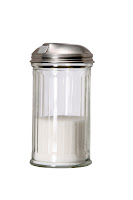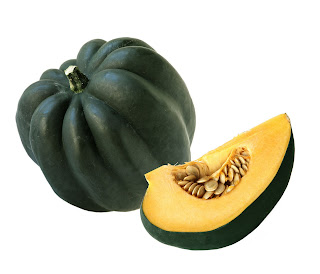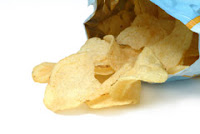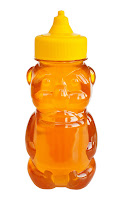Answer: BUSTED!
There may be good reasons for that half empty package. Actually, the empty space in a package is called “slack fill.” That space may be there to keep the product from breaking. In the case of potato chips, which break easily, the empty space can provide cushioning when bags are stacked. However, sometimes companies keep packages the same size (with the resulting empty space) because they don’t want to change their machinery to make a different size package. In the case of grocery stores, a standard package size is used to base the cost of shelf space that a company pays for.
In this environmentally conscious world, many consumers value a company that reduces packaging thus reducing the carbon footprint of their products. So, many companies are now aiming for less packaging and trying to avoid packages with a lot of empty space.
The federal Fair Packaging and Labeling Act protects consumers from the abuse of “slack fill” by companies, to some extent.
If you have a complaint about a food package with empty space, contact your state’s FDA complaint coordinator at http://www.fda.gov/Safety/ReportaProblem/ConsumerComplaintCoordinators/default.htm.
Visit the MissouriFamilies website for more information about nutrition and health.
Contributor: Ellen Schuster, M.S., R.D., Associate State Specialist, University of Missouri Extension, schusterer@missouri.edu, 573-882-1933
Tuesday, March 29, 2011
Myth: There's no reason for a lot of the food packages I buy at grocery stores to be half empty.
Labels:
Food packaging
Wednesday, March 23, 2011
Myth: It’s too hard to balance my calories so that I have a healthy weight.
Answer: BUSTED!
Here are 3 things you can start doing right now to help you balance your calories and achieve a healthy weight:
Contributor: Ellen Schuster, M.S., R.D., Associate State Specialist, University of Missouri Extension, schusterer@missouri.edu, 573-882-1933
Here are 3 things you can start doing right now to help you balance your calories and achieve a healthy weight:
- TRACK
Track the calories you get each day to get an idea of how many calories you are getting. You can do this online at http://www.mypyramidtracker.gov. - READ
Read Nutrition Facts labels (especially the calories and number of servings) and online calorie information about foods. Read calorie information in brochures that restaurants or fast food places provide onsite. Read calorie information on menus or menu boards at restaurants that provide this information. - CHOOSE
Choose these healthy behaviors:
- Choose to prepare food at home. YOU have control over what goes in your food, like less added fat and sugar.
- Choose to include more vegetables and fruits in your diet – they fill you up and keep you satisfied with less calories.
- Choose to be active each day.
- Choose smaller portions wherever you make food choices – at restaurants, at home and when you snack in front of the TV.
Contributor: Ellen Schuster, M.S., R.D., Associate State Specialist, University of Missouri Extension, schusterer@missouri.edu, 573-882-1933
Labels:
Healthy eating
Monday, March 21, 2011
Myth: It’s not safe to eat food imported from Japan.
Answer: BUSTED!
As of today no food is being exported from the affected area of Japan. The Food and Drug Administration is continuing its systematic efforts to screen food imports and get information about where they are grown, harvested or manufactured. FDA has a list of companies and manufacturing facilities in the affected area of Japan and will pay special attention to imports from those locations. You can read more about how food is tracked for safety at http://www.fda.gov/NewsEvents/PublicHealthFocus/ucm247403.htm.
Common foods that come from Japan include seafood, snack foods, dairy foods, processed fruits and vegetables and dietary supplements. All foods imported from Japan make up less than 4 percent of foods imported from all sources. Dairy products make up only one-tenth of one percent of all FDA-regulated products coming from Japan. Less than two percent of the seafood consumed in the United States is imported from Japan.
Visit the MissouriFamilies website for more information about food safety.
Contributor: Ellen Schuster, M.S., R.D., Associate State Specialist, University of Missouri Extension, schusterer@missouri.edu, 573-882-1933
As of today no food is being exported from the affected area of Japan. The Food and Drug Administration is continuing its systematic efforts to screen food imports and get information about where they are grown, harvested or manufactured. FDA has a list of companies and manufacturing facilities in the affected area of Japan and will pay special attention to imports from those locations. You can read more about how food is tracked for safety at http://www.fda.gov/NewsEvents/PublicHealthFocus/ucm247403.htm.
Common foods that come from Japan include seafood, snack foods, dairy foods, processed fruits and vegetables and dietary supplements. All foods imported from Japan make up less than 4 percent of foods imported from all sources. Dairy products make up only one-tenth of one percent of all FDA-regulated products coming from Japan. Less than two percent of the seafood consumed in the United States is imported from Japan.
Visit the MissouriFamilies website for more information about food safety.
Contributor: Ellen Schuster, M.S., R.D., Associate State Specialist, University of Missouri Extension, schusterer@missouri.edu, 573-882-1933
Labels:
Food safety
Thursday, March 17, 2011
Myth: Specific words on a food package help me make better food choices.
Answer: BUSTED!
Does the word “farmer” on a food label influence your decision to choose one food over another? Is a food marketed with “farmer” on the label an indication that the food is a healthy choice? Not necessarily. Consider two frozen lasagna options from the same company – one labeled as “farmers’ harvest” and one “lasagna.” Comparing the Nutrition Facts panels from each package you see that the “farmers’ harvest” lasagna has 360 calories, 12 grams of fat, 810 mg of sodium and 5 grams of fiber (it’s made with whole grain pasta). The other lasagna is similar when you look at the information on the Nutrition Facts panel: 350 calories, 11 grams of fat, 930 mg of sodium and 3 grams of fiber. It’s true that you get 2 more grams of fiber with the “farmers’ harvest” lasagna and 120 less mg of sodium but you also get a bit more calories and 1 additional gram of fat. So what’s a consumer to do?
Try to avoid being influenced by the marketing hype. Instead take the time to read the Nutrition Facts panel. When choosing frozen entrees, seek those that are about 300-500 calories with 10-18 grams of fat, 800 or less mg of sodium and 3 to 5 grams of fiber. These are not hard and fast rules, just guidelines. Remember that the frozen entrée you are choosing is only one of the many food choices you are making on any given day. If your allotted calories are 2000 calories for the day, 500 calories or more will leave you with only 1500 calories left for the day. And if you are seeking to get the 20-35 grams of fiber most of us need each day you will need to choose vegetables, fruits, beans and other whole grains for the rest of the day to get the fiber you need.

For quick and easy meal choices and other tips to help you choose frozen meals, visit the MissouriFamilies website at http://missourifamilies.org/features/nutritionarticles/nut332.htm.
Contributor: Ellen Schuster, M.S., R.D., Associate State Specialist, University of Missouri Extension, schusterer@missouri.edu, 573-882-1933
Does the word “farmer” on a food label influence your decision to choose one food over another? Is a food marketed with “farmer” on the label an indication that the food is a healthy choice? Not necessarily. Consider two frozen lasagna options from the same company – one labeled as “farmers’ harvest” and one “lasagna.” Comparing the Nutrition Facts panels from each package you see that the “farmers’ harvest” lasagna has 360 calories, 12 grams of fat, 810 mg of sodium and 5 grams of fiber (it’s made with whole grain pasta). The other lasagna is similar when you look at the information on the Nutrition Facts panel: 350 calories, 11 grams of fat, 930 mg of sodium and 3 grams of fiber. It’s true that you get 2 more grams of fiber with the “farmers’ harvest” lasagna and 120 less mg of sodium but you also get a bit more calories and 1 additional gram of fat. So what’s a consumer to do?
Try to avoid being influenced by the marketing hype. Instead take the time to read the Nutrition Facts panel. When choosing frozen entrees, seek those that are about 300-500 calories with 10-18 grams of fat, 800 or less mg of sodium and 3 to 5 grams of fiber. These are not hard and fast rules, just guidelines. Remember that the frozen entrée you are choosing is only one of the many food choices you are making on any given day. If your allotted calories are 2000 calories for the day, 500 calories or more will leave you with only 1500 calories left for the day. And if you are seeking to get the 20-35 grams of fiber most of us need each day you will need to choose vegetables, fruits, beans and other whole grains for the rest of the day to get the fiber you need.

For quick and easy meal choices and other tips to help you choose frozen meals, visit the MissouriFamilies website at http://missourifamilies.org/features/nutritionarticles/nut332.htm.
Contributor: Ellen Schuster, M.S., R.D., Associate State Specialist, University of Missouri Extension, schusterer@missouri.edu, 573-882-1933
Labels:
Food packaging,
Healthy eating
Tuesday, March 15, 2011
Myth: If I take a carnitine supplement it will help me lose fat quickly.
Answer: BUSTED!
Everyone would love to find that ‘magic pill’ that instantly sheds unwanted pounds. The current selection of weight loss pills on the market is endless and each one claims the same results – quick and easy weight loss. Carnitine is currently marketed as another ‘magic pill’ that promises to burn large amounts of fat in a short period of time. Carnitine is involved with the breakdown of fat in the body, and some believe that over-supplementing with this nutrient will cause fast weight loss. While this theory sounds promising, the current research shows that this supplement is not effective for weight loss. There is also concern with consuming greater than 3 grams per day because it has shown side effects that include nausea, vomiting, diarrhea, and could possibly lead to kidney disease. The major concern with carnitine and several other supplements is that the Food and Drug Administration does not regulate or regularly test them, and therefore these products cannot be guaranteed safe.
There is no magic pill!
The best and healthiest way to lose weight is to be physically active and have a well-balanced diet. Visit Missouri Families for additional nutrition and health information.
Contributors: Andrea Cossetta, St. Louis University Dietetic Intern & Mary Wissmann, MS, RD, LD, Nutrition and Health Education Specialist, St. Louis County, University of Missouri Extension, WissmannM@missouri.edu
Everyone would love to find that ‘magic pill’ that instantly sheds unwanted pounds. The current selection of weight loss pills on the market is endless and each one claims the same results – quick and easy weight loss. Carnitine is currently marketed as another ‘magic pill’ that promises to burn large amounts of fat in a short period of time. Carnitine is involved with the breakdown of fat in the body, and some believe that over-supplementing with this nutrient will cause fast weight loss. While this theory sounds promising, the current research shows that this supplement is not effective for weight loss. There is also concern with consuming greater than 3 grams per day because it has shown side effects that include nausea, vomiting, diarrhea, and could possibly lead to kidney disease. The major concern with carnitine and several other supplements is that the Food and Drug Administration does not regulate or regularly test them, and therefore these products cannot be guaranteed safe.
There is no magic pill!
The best and healthiest way to lose weight is to be physically active and have a well-balanced diet. Visit Missouri Families for additional nutrition and health information.
Contributors: Andrea Cossetta, St. Louis University Dietetic Intern & Mary Wissmann, MS, RD, LD, Nutrition and Health Education Specialist, St. Louis County, University of Missouri Extension, WissmannM@missouri.edu
Labels:
Supplements
Thursday, March 10, 2011
Myth: Items in health food stores are better for me.
Answer: BUSTED!
It is common for consumers to relate health food stores with healthy products, but this correlation is not always accurate. If you buy food or vitamin supplements from a health food store, those products are not necessarily healthier for you. Often they contain just as many preservatives and additives as the items bought at your neighborhood grocery store. In addition, because they have to buy from their wholesalers in smaller quantities, items purchased through health food stores are often more expensive without offering any greater nutritional benefit.
Many of the messages on health food package labels are not regulated by the Food and Drug Administration. While words such as “all natural” tend to entice customers, do not fall for the marketing ploy! Every company has a different definition of the term “natural,” and you could easily fall prey to marketing strategies without really enhancing your health.
Foods such as energy or granola bars found within a health food store have actually been found to contain larger amounts of saturated fats and calories than those purchased at the regular grocery store. Read labels and become a comparison shopper. There is nothing wrong with shopping in health food stores, but make sure you are an informed shopper!
Visit the MissouriFamilies website for more information about the use of “natural” on labels or for information about energy bars.
Contributors: Mallory Bratton, KU Med Dietetic Intern & Ellen Schuster, M.S., R.D., Associate State Specialist, University of Missouri Extension, schusterer@missouri.edu, 573-882-1933
It is common for consumers to relate health food stores with healthy products, but this correlation is not always accurate. If you buy food or vitamin supplements from a health food store, those products are not necessarily healthier for you. Often they contain just as many preservatives and additives as the items bought at your neighborhood grocery store. In addition, because they have to buy from their wholesalers in smaller quantities, items purchased through health food stores are often more expensive without offering any greater nutritional benefit.
Many of the messages on health food package labels are not regulated by the Food and Drug Administration. While words such as “all natural” tend to entice customers, do not fall for the marketing ploy! Every company has a different definition of the term “natural,” and you could easily fall prey to marketing strategies without really enhancing your health.
Foods such as energy or granola bars found within a health food store have actually been found to contain larger amounts of saturated fats and calories than those purchased at the regular grocery store. Read labels and become a comparison shopper. There is nothing wrong with shopping in health food stores, but make sure you are an informed shopper!
Visit the MissouriFamilies website for more information about the use of “natural” on labels or for information about energy bars.
Contributors: Mallory Bratton, KU Med Dietetic Intern & Ellen Schuster, M.S., R.D., Associate State Specialist, University of Missouri Extension, schusterer@missouri.edu, 573-882-1933
Labels:
Healthy eating
Tuesday, March 8, 2011
Myth: Honey is better for you than white sugar.
Answer: BUSTED!
While most people believe that honey is better for you than sugar, white sugar actually contains fewer calories than honey. Honey is natural and less refined than sugar, and also contains small amounts of minerals that are lacking in sugar. However, the mineral levels are so small that the amounts lack nutritional significance.

Overall, both of these products are very sweet and should be limited in consumption. It does not matter whether it is honey or white sugar, both products are high in calories. Stick to natural sugars found in fruits and resist the urge to add sugar to your coffee or honey to your morning tea.
Visit the MissouriFamilies website for more information about nutrition and health.
Contributors: Mallory Bratton, KU Med Dietetic Intern & Ellen Schuster, M.S., R.D., Associate State Specialist, University of Missouri Extension, schusterer@missouri.edu, 573-882-1933
While most people believe that honey is better for you than sugar, white sugar actually contains fewer calories than honey. Honey is natural and less refined than sugar, and also contains small amounts of minerals that are lacking in sugar. However, the mineral levels are so small that the amounts lack nutritional significance.

Overall, both of these products are very sweet and should be limited in consumption. It does not matter whether it is honey or white sugar, both products are high in calories. Stick to natural sugars found in fruits and resist the urge to add sugar to your coffee or honey to your morning tea.
Visit the MissouriFamilies website for more information about nutrition and health.
Contributors: Mallory Bratton, KU Med Dietetic Intern & Ellen Schuster, M.S., R.D., Associate State Specialist, University of Missouri Extension, schusterer@missouri.edu, 573-882-1933
Labels:
Healthy eating
Friday, March 4, 2011
Myth: I like to add a sweet taste to my fresh salad so dried fruit is my only choice.
 Answer: BUSTED!
Answer: BUSTED!Consider the wide world of winter squash or sweet potatoes as one way to add sweetness and a new taste to your salad. Winter squashes like butternut squash or acorn squash are low in calories (about 60 calories in 1 cup raw squash), sweet potato is a little higher in calories (about 115 calories for 1 cup raw). Consider roasting in the oven as this increases their sweetness and flavor. Or after cooking and before dicing, sprinkle some cinnamon on the pieces for even more flavor.

Squash or sweet potatoes have fiber and potassium. Dietary potassium can lower your blood pressure by acting against the negative effects of sodium on blood pressure. Eating vegetables and fruits is associated with reduced risk of some chronic diseases such as heart disease, stroke and some cancers.
For other ideas about using squash, visit MissouriFamilies at http://missourifamilies.org/features/nutritionarticles/nut240.htm.
To get you started eating more fruits and vegetables, use the MU Extension resource Seasonal and Simple. To obtain a copy of Seasonal and simple, contact your local MU Extension office or go online to http://extension.missouri.edu/publications/DisplayPub.aspx?P=MP909.
Contributor: Ellen Schuster, M.S., R.D., Associate State Specialist, University of Missouri Extension, schusterer@missouri.edu, 573-882-1933
Labels:
Healthy eating
Wednesday, March 2, 2011
Myth: All I need to do to cut down on the amount of sugar in my diet is drink less sugar-sweetened beverages.
Answer: BUSTED!
The recent 2010 Dietary Guidelines say that we should "significantly reduce" our intake of added sugars. Strong evidence shows that if we eat foods low in calories this improves weight loss and weight maintenance, and also may be associated with a lower risk of type 2 diabetes in adults. Low calorie foods are also foods low in added sugar which make up about 16% of the total calories in American diets.
What are added sugars?
High fructose corn syrup, white sugar, brown sugar, corn syrup, corn syrup solids, raw sugar, malt syrup, maple syrup, pancake syrup, fructose sweetener, liquid fructose, honey, molasses, anhydrous dextrose and crystal dextrose
The major sources of added sugars in our diets are soda, energy drinks and sports drinks, desserts like granola bars, sugar-sweetened fruit drinks, flavored yogurts and candy, but there are other foods that have sugar in them.
Some alternatives to the choices above:
Contributor: Ellen Schuster, M.S., R.D., Associate State Specialist, University of Missouri Extension, schusterer@missouri.edu, 573-882-1933
The recent 2010 Dietary Guidelines say that we should "significantly reduce" our intake of added sugars. Strong evidence shows that if we eat foods low in calories this improves weight loss and weight maintenance, and also may be associated with a lower risk of type 2 diabetes in adults. Low calorie foods are also foods low in added sugar which make up about 16% of the total calories in American diets.
What are added sugars?
High fructose corn syrup, white sugar, brown sugar, corn syrup, corn syrup solids, raw sugar, malt syrup, maple syrup, pancake syrup, fructose sweetener, liquid fructose, honey, molasses, anhydrous dextrose and crystal dextrose
The major sources of added sugars in our diets are soda, energy drinks and sports drinks, desserts like granola bars, sugar-sweetened fruit drinks, flavored yogurts and candy, but there are other foods that have sugar in them.
- Baked beans: up to 21 grams of sugar per half-cup (teaspoons of sugar)
- Fat-free fruit cookie: 12 grams of sugar per two-cookie serving (3 teaspoons of sugar)
- Slim shake in a can or bottle: 18 grams of sugar (4½ teaspoons of sugar)
- Some salad dressings: 5-8 grams of sugar for 2 tablespoons (1-2 teaspoons of sugar)
Some alternatives to the choices above:
- Buy foods without sauces and add your own seasonings. Start with any kind of canned or cooked beans, add apples and winter squash like butternut or acorn squash which add a sweet flavor. Cloves, cinnamon and nutmeg will also add a sweet flavor. Try getting used to a less sweet taste by mixing some baked beans with regular beans.
- Reach for a naturally sweet fruit instead of cookies or slimming shakes. Fruits are high in fiber, which will fill you up, and low in calories.
- Try balsamic vinegar instead of salad dressing. The tart flavor of balsamic vinegar is a nice combination with mandarin oranges, strawberries or blueberries when added to salads.
Contributor: Ellen Schuster, M.S., R.D., Associate State Specialist, University of Missouri Extension, schusterer@missouri.edu, 573-882-1933
Labels:
Healthy eating
Subscribe to:
Posts (Atom)




